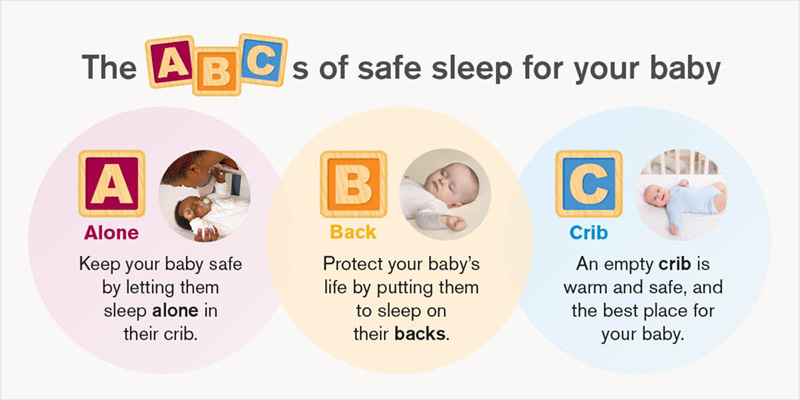Many new parents worry about the possibility of sudden unexplained infant death syndrome (SUIDS), more commonly known as sudden infant death syndrome (SIDS). Defined as the sudden, unexplainable death of an infant under the age of 1, this scenario rightfully frightens parents around the world.
Unfortunately, SIDS is the leading cause of death for babies between the ages of 1 month to 1 year of age. Death comes quickly, usually during sleep. Many times, the child will seem healthy and happy beforehand. The exact cause is currently unknown. However, what is known is that parents can take three very specific actions to greatly reduce the risk of SIDS.
Kirsten Sorum, DO, a Pediatrician and Neonatology fellow for Loyola Medicine, discusses more about this syndrome and how parents can keep their baby safe. "The majority of SIDS cases happens at home and often times at night while sleeping," says Dr. Sorum.
Never share a bed with your infant
Many parents let their infant sleep with them at night in their bed. There are many reasons why parents may choose to do this. They may feel it brings them closer to their child, makes them feel more protective, or parents unintentionally fall asleep in bed while breastfeeding or cuddling. However, no matter the reason, bed sharing poses a very high risk of suffocation for infants.
"Babies who fall asleep with their parents on the couch or bed can fall into a crevice or roll under blankets and suffocate," says Dr. Sorum. "The majority of SIDS cases have occurred when the infant was in the bed with parents."
If you want to feel closer to your baby, consider room sharing instead of bed sharing. In fact, room sharing has been shown to reduce the risk of SIDS by 50%.
Even if someone you know tells you they never experienced problems sharing a bed with their baby, it is not recommended for infants younger than 12 months old. There are too many risk factors that could lead to the suffocation or sudden death of your child.
Lay your infant on their back
In addition to room sharing, there are several other sleep practices that can help prevent SIDS. The primary one is laying your child on a flat, firm sleeping surface on their back. Research has shown that laying your child on their back versus their stomach or side dramatically lowers the risk of SIDS.
Also, make sure there is nothing in your baby's crib or sleeping space. This includes pillows, sheets, stuffed animals and blankets. These can increase the risk of suffocation or strangulation. An infant can be swaddled while laying on their back. However, this practice should stop when your baby is able to roll over on their own, which usually occurs between two to four months. After that, you don't have to place them on their back anymore. Movement at this stage is good for your baby's growth and development.
"The surface your child sleeps on should be firm and free of other items," says Dr. Sorum. "If you decide to swaddle your child, make sure their arms are free. If your child does roll over then they have use of their arms."
A dedicated sleeping surface is also important, but it doesn't have to be a crib. It can be a bassinet, playpen or even a bedside sleeper that attaches to your bed. Just make sure whatever product you use meets the standards from the Consumer Product Safety Commission (CPSC). Products that meet these standards will have a Children's Product Certificate (CPC). Whatever your infant sleeps on, make sure it's firm. Any surface that inclines more than 10 degrees is considered dangerous and a suffocation risk.
Don't clothe your infant too heavily
Besides inappropriate sleeping environments, overheating is another major risk factor for SIDS. Many parents dress their infants with too many clothes, too much bedding, or both. Even in the winter, unless your child is sick or has a fever, they don't need extra layers.
When sleeping, keep the room at a comfortable temperature, usually no more than 68 degrees Fahrenheit. As you check on your infant throughout the day or night, make sure they aren't overheating. They may be sweating or their stomach feels hot to the touch. Don't worry if their hands or feet are cold; that's normal.
"Babies don't need an excessive amount of clothing," says Dr. Sorum. "The rule of thumb is to dress them in one more layer than what you're wearing. So if you're wearing shorts and a t-shirt then your child would wear shorts, t-shirt and a light outer layer."
Remember the ABC's of safe sleep for infants
Before putting your baby to sleep, remember this acronym to prevent sudden infant death. Babies should sleep alone on their back in a crib.

Why Loyola Medicine?
Our Loyola primary and specialty care offices are conveniently located throughout Chicago’s western and southwestern suburbs. Our Pediatric department at Loyola Medicine has one of the most comprehensive and advanced teams in the nation.
To make an appointment, call 888-584-7888 or schedule an appointment online.
Kirsten Sorum, DO, is a Pediatrician at Loyola Medicine. Dr. Sorum completed her residency at Advocate Christ Medical Center and worked as a NICU Hospitalist for 10 years before joining Loyola University Medical Center's Neonatal-Perinatal Medicine fellowship.
Dr. Sorum takes great pride in helping children of all ages, and is especially passionate about lowering the rates of SUIDS. Her expertise and knowledge is used to treat children and inform parents at Loyola Medicine.
Book an appointment today to see Dr. Sorum or another Loyola physician by self-scheduling an in-person or virtual appointment using myLoyola.

